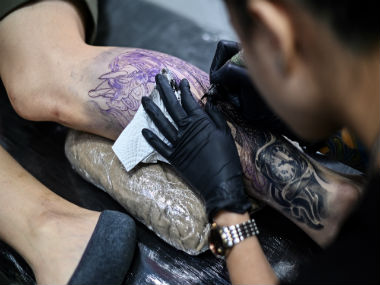A permanent tattoo is a big commitment. It’s usually for life - laser tattoo removal isn’t as easy as just erasing a bad drawing. If you’re thinking of marking the end of this year with a new tattoo, you might want to arm yourself with all the health aspects of it first. Tattoos are basically insertion of solid pigments, dissolved in a liquid carrier, into the skin to create the colour. The liquid carrier can be water, witch hazel, glycerine, propylene or ethanol. [caption id=“attachment_7779161” align=“alignleft” width=“380”]  Representational image. Image source: Getty Images.[/caption] But since human skin cells live for only 2-3 weeks, shouldn’t the tattoo also last only that long? Well, here’s why it doesn’t.
Why makes tattoos permanent?
The tattoo needles with ink stuck between them puncture the skin about 50-3000 times per minute. These needles go through the epidermis (outer layer of skin) and until the dermis (second layer of skin). The dermis contains blood capillaries, sweat glands, and nerve endings - this is why tattoos are sometimes painful. After the needles make holes, the capillary action draws the ink into the dermis. Capillary action is the ability of any liquid to move in narrow spaces without any external help. Ink molecules like to stick to each other (cohesion) as well as to other substances (adhesion). When the adhesion of ink molecules to the walls of the holes is stronger than the cohesion between the ink molecules, the ink travels down the holes. Once the ink reaches the dermis, the immune system gets alarmed. It deploys macrophages (immune cells) to help close the punctured holes. Since the tattoo ink is a foreign body, macrophages start gobbling them up and attempt to take them away to destroy them but get stuck in the gel matrix of the dermis and stay there forever.
Do different coloured inks have different components in them?
There are about 9 colours that are most frequently used in tattooing - they contain different ingredients. Black is the most commonly used tattoo ink. Natural black pigment is made from magnetite crystals, powdered jet, wustite, bone char, and amorphous carbon from combustion (soot). The ingredients of black ink are iron oxide, carbon and logwood. Brown ink is made of ochre (iron oxides mixed with clay), blue contains sodium aluminium silicate (lapis lazuli) and copper silicate (Egyptian blue). Red ink carries an increased risk of allergy and contains cinnabar (a toxic mineral) and naphthol pigments. The other commonly used inks are white, violet, yellow, green and orange. All of them contain a different combination of chemicals. It’s best to do your research before you head to the tattoo studio.
How can tattoos go wrong?
The toxic ingredients of the tattoo ink and unhygienic practices are the main reasons behind the significant health risks linked with tattooing. Ideally, the pain and redness should not be there after the first week of getting tattoed and by the 5th or 6th week the healing should be complete. Allergic reactions: Mild itching and redness are normal in tattoo healing, but if the symptoms progress to pus drainage and foul odour then you must immediately seek medical help. Scarring: A scar begins to develop when the tattoo artist presses the needles in the deeper tissue beneath the skin. As the damage is too high, it cannot heal itself and so the body begins repairing and replacing the damaged tissue with collagen. This collagen makes the tattooed skin look swollen and bumpy and could cause a change in colour as well. Phototoxic reactions: You could have allergic reactions, like extreme redness and swelling of the tattoo area, from exposure to light. Red, blue and black tattoos predominantly cause sun-related allergic reactions followed by the remaining colours.
The vegan ink
Doctors recommend people to opt for vegan inks or plant-based inks that contain less risk of causing any sort of harm. Black ink is generally derived from the soot of charred animal bones, but the vegan one is made from a pigment extracted from logwood. Similarly, the pigment carrier solutions were traditionally made from animal fat (glycerin) but now they’re also being derived from plant-based fats (glycerol). For more information, please read our article on Skin Allergy_. _ Health articles in Firstpost are written by myUpchar.com, India’s first and biggest resource for verified medical information. At myUpchar, researchers and journalists work with doctors to bring you information on all things health.


)

)
)
)
)
)
)
)
)



